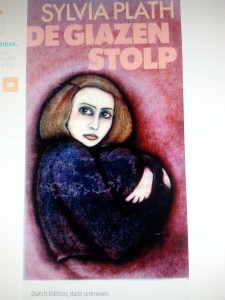http://youtu.be/MkRmnrei3FI
Tag Archives: The Bell Jar
My Cover
Part 2
I chose to create this cover because it reminds me of the story of Esther Greenwood in The Bell Jar. The rose is red and fiery which represents the inner Esther. Flowers are life , without the proper care a rose will die. The background is scenic, but camouflaged through the off white petals. That scene represents the beautiful death that Esther imagines as she is trapped inside this bell jar. The beautiful rose is suffocating, as Esther Greenwood in The Bell Jar.
One and Fifty (The Bell Jar a Covers)
The Bell Jar by Sylvia Plath has many themes. The themes for this novel were expressed in the novel through words as well as through the illustrations on the cover. The Bell Jar has had many covers since it’s first official publication.
The Bell Jar, first Heinemann edition, was published on January 14, 1963 under WillIam Heinemann Ltd. . This Novel was published under the pseudonym Victoria Lucas. Sylvia Plath used this fictitious name in an attempt to avoid hurting the people she cared for in America. Sylvia Plath actually requested that The Bell Jar never be published in America. Sylvia Plath died , said from suicide, shortly after the release of this novel. Hughes gave permission to have her name revealed. Sylvia Plath attempted to publish her novel before William Heinemann Ltd. . The Bell Jar was rejected by Eugene F. Saxton fellowship , affiliated with Harper and Row. They were said to be disappointed in the manuscript. The novel which first names were “Diary Of A Suicide” and “The Girl in The Mirror”. This novel was said to be juvenile and overwrought by Eugene F. Saxton fellowship. Though rejected in the past by Harper and Row, Heinemann Ltd. Saw something special in this novel.
A bell jar is a bell shaped usually glass vessel designed to cover objects or to contain gases or a vacuum.(www.https//:merriamwebster/belljar)The cover of the first published novel of The Bell Jar has interesting artwork of a woman sitting in a chair, inside of a bell jar. This to me is symbolic to one or more of the themes in the novel.
One theme that comes to mind in comparison of the illustration on the cover of the first published edition of The Bell Jar by Sylvia Plath is suppression. The fact that this woman on the cover of the novel is closed inside of a bell jar is metaphorical to Esther being trapped inside the world that she lives in. Esther was unlike any of the other girls that she stayed in the all girls hotel with in New York. More times than not she would suppress her thoughts and true feelings in fear of judgement from others.
Another theme that comes to mind when analyzing the cover of the first publication of the novel is death. This death would be through suffocation. It is all symbolic to the death of the person who appeared to be Esther and the person Ms.Greenwood really was. “Death must be so beautiful . To lie in the soft brown earth, with the grasses waving above one’s head, and listen to silence. To have no yesterday, and no tomorrow. To forget time, to forgive life, to be at peace. ” Life and all that it involved, to Esther seemed to be suffocating and the thought of death would be more peaceful.
The woman inside the bell jar on the cover of the first publication has body language displaying stress and grief, being suppressed, and suffocating inside a glass jar. The illustration of the cover depicts this moment in the story by displaying such disgust with life that she feels that whatever death had to offer must be beautiful. Esther Greenwood wold bet that death was better than life. This cover was just the beginning of the many covers to follow.
In 2013 the 50th Anniversary edition of The Bell Jar was published. This edition was done by Faber and Faber. This illustration of The 50th anniversary edition was criticized by many of the readers and followers of Sylvia Plath’s poetry. This cover was said to glorify the story of depression and suicide that was initially being told by Sylvia Plath. Critics say that this cover will attract only a female group of readers due to the bias art on the cover. Many of Ms.Plath’s readers suggest that Sylvia Plath would herself be unsatisfied with this new cover published by Faber and Faber.
This cover has a picture of a woman looking into the mirror of a compact makeup palette. This woman looks suspenseful, and is applying bright red lipstick . The background is also in a bright red color. Though the red color will bring attention to the book itself , the illustration may stray some readers away. True Sylvia Plath followers understand what’s conveyed in the book as opposed to what is on the cover.
Faber and Faber stands behind the publication of the 50th Anniversary Edition . Faber and Faber’s intention was to keep backlist novels like ” The Bell Jar” in the hands of new readers. They believed that the new packaging of the novel was to draw new readers to old writing.
The Bell Jar by Sylvia Plath has many themes. Amongst these themes would be depression, suicide, suppression, and death. Freedom, liberation, and women’s independence are rarely discussed in reference to “The Bell Jar”. Though Esther Greenwood lived in a time of oppression mentally, her conscious was aware. It seemed that her depression may have originated subconsciously as a result of her upbringing, and mentality. Had Esther not held this stigma of mental Illness her aspirations may have reached their full potential.
In the 1950’s Esther interned at a magazine in New York. While Interning Esther stayed at a hotel called the Amazon. She had initially rejected those women who lived at the all women’s hotel . That rejection was in fear of rejection from these well to do women. Esther felt that she was different. Though thoughts of freedom to be liberated exist the pressure of being who everyone else would expect was over baring.
Esther Greenwood did not like the idea of being overpowered or protected In a world where she was expected to do just that. “To the person in the bell jar, blank and stopped as a dead baby, the world itself is a bad dream”. Her liberation was thought, but never enacted. Esther had been held so long to the preservation of being protected and thought for, she feared the security of a man. “That’s one of the reasons I never wanted to get married. The last thing I wanted was infinite security and to be the place an arrow shoots off from. I want change and excitement and to shoot off from a Fourth of July rocket”.
Red is a noun, one of its meanings are , emotionally charged terms used to refer to extreme radicals or revolutionaries(dictionaryapp). Not only is the cover of the new 50th Anniversary edition of The Bell jar red, but the woman on the front is applying bright red lipstick as well. The cover of this new edition seems to be a bit misleading. You will get a different idea from the cover then the actual story being told. Women were actually assumed to be domestic beings, and in accordance with the prospect of being what society thought them to be.
The new cover for The Bell jar has a conspicuous suspiciousness. The first cover of the Bell Jar published in the UK in 1963 had a more apparent look. When you looked at the image of this woman being stuck inside of a bell jar like an ornament, you get the sense that she is suppressed. I understand the controversy and ambivalence about the new cover for The Bell Jar.
The new cover states excitement, mischief and mystery. The fact of the matter is that The Bell Jar by Sylvia Plath is a manuscript about a woman who is depressed and trying to fight the demons of suicide. Esther Greenwood was dreaming of freedom and liberation, while suffocating in that glass jar from oppression. The new cover makes The Bell Jar appear to be a new and different story.
There is a big difference in the cover of the first published edition of The Bell Jar by Sylvia Plath, published under the name Sylvia Lucas in comparison to the 50th Anniversary cover published in 2013 by Faber and Faber. The first cover tells the story , the most recent cover is deceptive. Overall throughout all of the controversy and the changing covers of The Bell Jar by Sylvia Plath, the story of “Esther Greenwood” remains the same. The different covers just represent the perceptions of novel “The Bell Jar”.
www.wikipedia.com/sylvia plath/thebelljar
www. Fabero.co.uk/about/press/bell-jar
Discussion for Tuesday: Final thoughts on The Bell Jar
As we finish The Bell Jar and finalize Project #2, what final thoughts do you have? Specifically, what do you think about the ending? What do you understand better about earlier parts of the novel now that you have finished it and come to understand Esther’s character and experiences? Write a comment–roughly 150 words–here by Tuesday, and reply to another comment–100-150 words by Thursday–to help us wrap up our discussion.
A few other points:
I will post on Tuesday another comment-and-reply request for the texts we’re discussing in class this week.
Remember that if you want to meet with me to discuss Project #2, there are appointments available on Tuesday and Wednesday. If you meet with me for one of those appointments, I will extend your deadline for Project #2. So far, about a third of the class has signed up. If you are interested but no times fit your schedule, please let me know as soon as possible and I will see if I can add in a time to accommodate you.
I look forward to meeting with you, and to reading your comments and projects!
The Meaning of a Cover
The Bell Jar by Sylvia Plath is a novel about a young woman’s descent into depression and mental illness. It is the story of Esther Greenwood a nineteen year-old woman that actually seemed to be quite lucky. She went to a good university, had a loving mother, an aspiring doctor as a boyfriend, she even won a contest and a trip to New York with a famous women’s magazine. Even with all of that she felt different and unhappy and trapped. She behaved erratically developed a different identity and desired to commit suicide. This story reflects the own life of the author as well, who not too long after publishing the book succeeded in her last attempt and commited suicide. It is evident that this novel is fairly morbid and deep, and it is also a world famous novel.This novel has been translated to many different languages and the cover art has been very different for each country. It is noticeable that each country has a different take on what cover is most befitting to this novel. Some cover arts are like the one from the Dutch edition of the novel; titled, De Giazen Stolp This cover shows a woman in long black clothing slumped on the ground and hugging her knees to her chest while looking up. This cover art idea could be extracted from the section just before Esther goes to the mental hospital, where she decides to crawl into a hole in her basement while overdosing on pills. This cover clearly shows that the book is about the darkness and struggles of a young woman. It is an appropriate for anyone wondering what this novel holds behind that cover. Other covers for this book, American covers in particular, decide to go in a different direction with their designs. The cover from the publishers “Faber and Faber” from the year 2009 take a lighter approach to the cover design. This version shows a woman with a model figure in an non-distinctive white strapless gown with seemingly long hair gathered in a low bun. After knowing exactly what the book is about, this cover seems rather innapropriate. This looks more like a novel about a bride at her wedding. It can only be imagined that this cover idea came from the beginning of the novel where Esther is still in New York living the dream of every other girl her age. Because this version of the novel is somewhat current, it can be inferred that the company went with this friendlier idea to encourage more sales with a younger, more modern generation. There is a famous saying that goes, “you cannot judge a book by it’s cover.” Though this is true, there should be a limit to how far off the subject of a novel the cover art should stray. To those who have not read that book, they would be mislead; and to those who have read it, they will be disgruntled to say the least.







